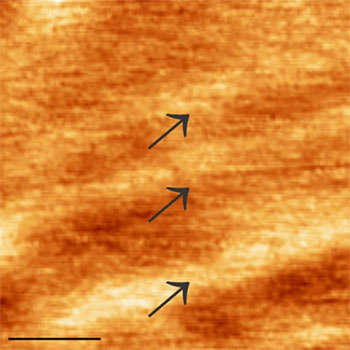
Mechanical Engineering Professor Mehmet Baykara’s latest discovery in two-dimensional (2D) materials will have implications for future space missions, as well as nanotechnology on Earth.
Since the Nobel prize-winning discovery of 2D materials in 2004, scientists have believed the crystalline materials consisting of a single layer of atoms intrinsically have ripples that dictate their frictional properties on nanometer-length scales. While such ripples were observed using methods such as electron microscopy, they were never seen during friction experiments, making it hard for scientists to form connections between the presence of ripples and the peculiar frictional properties they exhibit.
Now, Baykara and his nanoscience lab at UC Merced, together with collaborators at McGill University in Canada, have for the first time detected the presence of these ripples on the 2D material molybdenum disulfide (MoS2) using atomic force microscopy — the main tool scientists use to study friction on the nanoscale.
Their discovery allows concrete connections to be made between the presence of the ripples and the frictional characteristics exhibited by MoS2, especially its direction dependence.
MoS2 is a particularly important material used as a “solid lubricant” necessary for nanomachines and for space missions.
“Space is extremely cold, and you are under vacuum: Liquid lubricants that we use in conventional machinery would simply freeze up or evaporate,” Baykara explained. “On the other hand, in very small, nanoscale machines, conventional lubricants just ball up. For such applications, what you really need are solid lubricants like MoS2.”

Understanding the frictional properties of 2D materials such as MoS2 in depth will help in designing equipment that employs solid lubricants.
“Now that we can see the presence of these ripples and measure their properties, we have a critical piece of information that will help us figure out in what fashion we need to use solid lubricants in nanomachines for optimal performance,” Baykara said.
A recent paper in the journal npj 2D Materials and Applications details the results of Baykara and his collaborators’ work. The research was supported by the Merced nAnomaterials Center for Energy and Sensing (MACES), which has several affiliates working on projects for NASA. Baykara is also affiliated with the Health Sciences Research Institute.
While trying to actively control the distribution and the direction of ripples could be a potential area of future research, Baykara said his lab will primarily extend their work to more recently discovered members of the 2D materials family.
“Friction is a fascinating phenomenon and we, as a community of scientists and engineers, are still trying to understand its basic physical principles,” Baykara said. “2D materials, thanks to their extraordinary properties, provide an excellent platform to search for the fundamentals of friction.”

